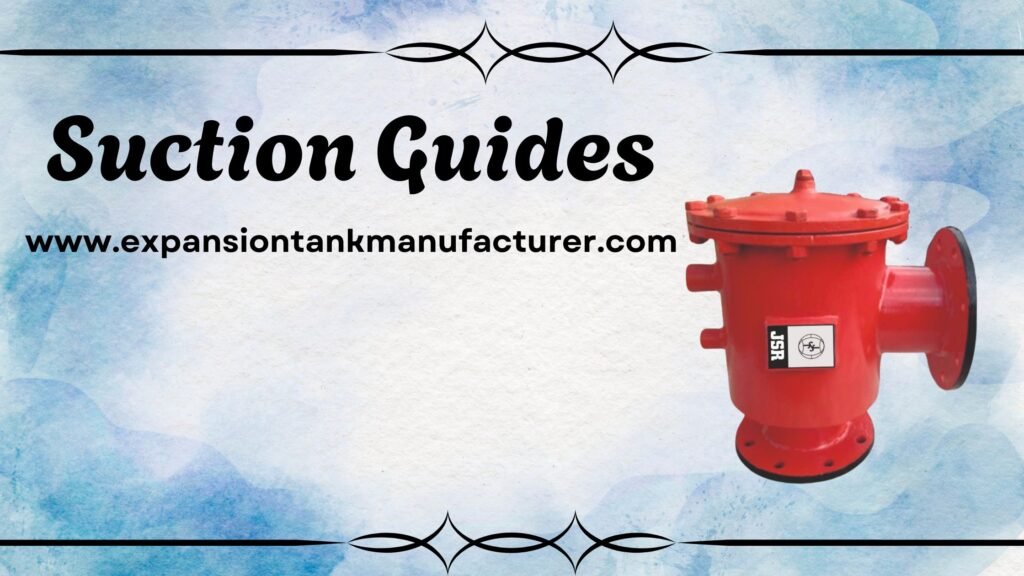Pumps are at the heart of many industrial fluid systems, guaranteeing the smooth flow of liquids through numerous applications. In the fast-paced and fast-moving world of a place like Delhi, which hosts some of the city’s major industries – ranging from water treatment plants to HVACs and chemical manufacturers, among others, pump efficiency becomes extremely necessary. An oft-neglected part that plays a crucial role in maximizing pump efficiency is the suction guide.
A suction guide is a device meant to guide the fluid entering the suction port of a pump so that flow dynamics are improved, and turbulence is minimized for smooth running of the pumps. It plays a crucial role in ensuring pumps operate at an optimal level in industrial applications dependent on fluid systems for critical operations.
In this blog, we will find out how suction guides play an important role in optimizing pumps in Delhi’s fluid systems, what benefits they bring, and why industries in Delhi should consider their incorporation into the pump system.
What is a Suction Guide?
A suction guide is an item inserted in the suction line of a pump for smooth entry of fluid into the pump. The purpose of the suction guide is to avoid any interruptions in the flow, which cause turbulence and the formation of a vortex. Both factors have adverse effects on the pump’s efficiency. Aerodynamic designs of suction guides help in smoothing the incoming fluid flow into the pump, reducing energy loss and thus enhancing performance.
In a place like Delhi where industries are operated with pumps of water supply, chemical processing, and HVAC applications a suction guide increases pump efficiency by reducing maintenance and increasing the time of equipment life.
Why Suction Guides are Essential for Optimizing Pumps in Delhi?
1. Improved Flow Efficiency
One of the major uses of a suction guide is that it enhances the fluid flow efficiency of the fluid entering the pump. Fluid without proper guidance going into the pump is prone to turbulence, leading to inefficiency and higher energy consumption. Optimizing flow efficiency is very essential in Delhi where continuous fluid flow is required by industries such as chemical manufacturing and HVAC systems for saving operational costs and enhancing system performance.
Suction guides help smoothen fluid entry into the pump and prevent cavitation to ensure relatively constant flow rates. This optimization has a double effect: it improves pump efficiency and saves energy, which leads to considerable cost savings over time.
2. Preventing Cavitation
Cavitation is the phenomenon that occurs when the pressure of the incoming fluid drops below its vapor pressure and, as a result, creates vapor bubbles. As these bubbles move into areas with higher pressures in the pump, they collapse and create shock waves that may damage the parts of the pump and reduce the efficiency of the pump. In Delhi, where many water treatment plants and petrochemical facilities heavily rely on pumps, cavitation may severely damage the machinery and drive up maintenance costs.
Suction guides prevent cavitation by ensuring that the fluid entering the pump is at the right pressure and flow rate, thus safeguarding the pump and extending its operational lifespan. The reduction of risks of cavitation contributes to minimizing maintenance costs and improving the reliability of fluid systems.
3. Enhanced Pump Longevity
Pumps experience early wear and tear when encountering turbulence, cavitation, and improper fluid flow. Thus, the period over which pumps will be put to use shortens, coupled with the occurrence of frequent repair and replacement services. Suction guides protect the pump from problems of turbulence and cavitation that occur when there is improper delivery of fluid to the pump; thus, resulting in less pump stress and hence its longer functioning time at optimized performance.
This is an important consideration because pump efficiency as well as durability would need to be sustained for extended periods when it comes to Delhi where manufacturing processes play an essential role for the economy. This can all be made sure if a firm installed suction guides.
4. Energy Savings
Energy consumption in the pumps is directly proportional to fluid flow. Fluid enters the pump without any shock if the flow into the pump is smooth. Therefore, it consumes less energy while operating. Energy loss due to fluid friction and other forms of losses will be reduced, ensuring peak efficiency for the pump if the suction guide smoothes out the flow of fluid.
Energy efficiency is the main factor that ensures the reduction of operation costs for many industries in Delhi. This includes water distribution networks and HVAC systems requiring ample supplies of energy to sustain fluid systems. Optimizing fluids using suction guides could prove to save significant amounts of energy on the part of industries in Delhi. Energy savings would result in cost-cutting measures as well as ensure environmental sustainability.
5. Reduction of System Wear and Tear
In Delhi’s fluid systems, pumps, valves, and pipes experience significant wear and tear due to constant fluid movement and pressure fluctuations. Turbulence and improper fluid flow exacerbate this problem by putting additional stress on the pump and other system components.
By allowing smooth and efficient suction flow into the pump, suction guides reduce the mechanical forces acting on the pump and related components. This results in fewer maintenance issues and longer system life as for industries that depend on fluids for continuous operations.
Types of Suction Guides for Different Applications
The design and configuration of suction guides vary based on the application and type of pump. Some common types are:
- Straight Suction Guides: These are simple suction guides that guide the fluid flow into the pump’s suction inlet in a straight line. They are widely used in large industrial applications such as water treatment and oil and gas.
- Elbow Suction Guides: Elbow suction guides are used where the suction line has to be changed in direction. For example, in multi-fluid source pumping systems, elbow suction guides assist in smooth flow through bends without turbulence.
- Axial Suction Guides: These are designed to streamline the fluid entering the pump in an axial direction. Axial suction guides are very helpful in centrifugal pumps used in high-flow systems, such as those in HVAC or chemical processing plants.
Benefits of Suction Guides for Delhi’s Pump Systems
- Optimized Flow: Suction guides ensure that fluid enters the pump smoothly, reducing turbulence and ensuring a consistent flow rate.
- Increased Efficiency: By preventing cavitation and optimizing flow, suction guides help pumps operate more efficiently, leading to energy savings and cost reductions.
- Improved Pump Longevity: Proper fluid guidance reduces the stress on pumps, increasing their lifespan and reducing the need for frequent maintenance.
- Enhanced System Reliability: Suction guides contribute to the overall reliability of fluid systems by ensuring consistent and smooth operation.
- Cost Savings: With less energy consumption, reduced wear and tear, and fewer maintenance issues, suction guides help businesses in Delhi reduce operating costs.
Why Industries in Delhi Need Suction Guides?
Delhi is the hub of all diversified industries, so fluid systems there have different problems. Water treatment, HVAC, and chemical processing industries are examples of industries relying on pumps for handling large amounts of fluid; any inefficiency in these fluid systems leads to significant operational disruptions.
The integration of suction guides within fluid systems in Delhi is important because it optimizes pump performance and prevents damage; it also enables energy efficiency. By incorporating the devices, business organizations can help improve the reliability and longevity of their fluid systems while contributing towards cost savings and operational excellence.
Conclusion
Suction guides are a critical component of pump efficiency in the industrial systems of Delhi. Improving flow efficiency, preventing cavitation, reducing energy consumption, and extending the life of pumps are all part of suction guides that help optimize fluid systems. By installing suction guides, industries in Delhi, whether water treatment, chemical processing, or HVAC systems, can ensure that their pumps run smoothly, efficiently, and for a longer period.
In a city that thrives on industrial progress, adopting innovative solutions like suction guides is the key to maintaining high-performance systems and staying ahead in the competitive market.
FAQs
1. How do suction guides improve pump performance?
Suction guides help by ensuring smooth fluid flow into the pump, reducing turbulence and preventing cavitation, thus improving the pump’s overall performance.
2. Can suction guides help reduce energy consumption?
Yes, by optimizing the flow of fluid, suction guides reduce energy loss, allowing pumps to operate more efficiently and use less energy.
3. Why is cavitation a concern for pumps in Delhi’s industries?
Cavitation can damage pumps and reduce their efficiency, leading to increased maintenance costs. Suction guides help prevent cavitation by ensuring proper fluid flow into the pump.
4. Are suction guides cost-effective?
Yes, suction guides are a cost-effective solution that reduces energy consumption, minimizes maintenance costs, and enhances pump longevity, offering significant long-term savings.
5. In which industries in Delhi can suction guides be used?
Suction guides are essential in industries such as water treatment, chemical processing, HVAC, and oil and gas, where pumps play a critical role in fluid systems.




